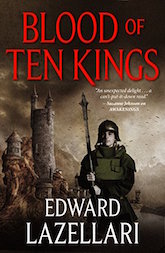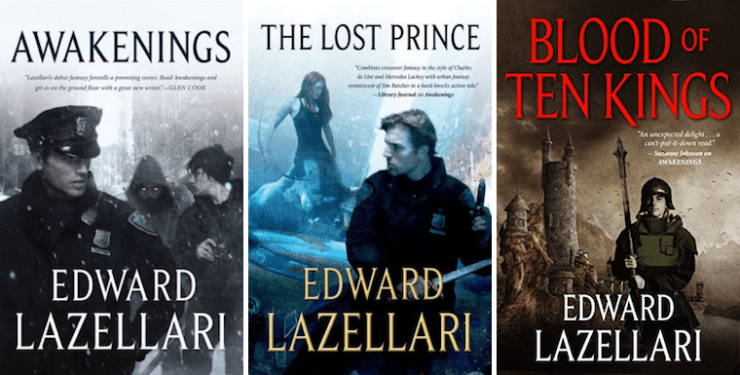The Empire of Fantasy, unlike Gaul, can be divided, very roughly, into two parts, based on where it is set. On one side there is fantasy that focuses and is set on Earth. This is contemporary fantasy, with urban fantasy being the dominant form and flavor of that particular fantasy. From Seanan McGuire to Jim Butcher, it is a familiar and extremely popular half of fantasy, even if it is not quite as predominant as it once was.
On the other side, there is secondary world fantasy, which comes in sizes, scales, and flavors from sword and sorcery, to low fantasy to city-state fantasy, and all the way to epic fantasy that spans kingdoms, continents, and worlds. Secondary world fantasy, whether in the Tolkien, Jordan, Jemisin, Martin, or Elliott tradition, comes in a multitude of settings and subtypes. Recent developments, from grimdark to the increased use of settings and cultural inspirations far beyond Medieval Europe have made secondary world fantasy a hotbed of experimentation.
Portal fantasies bridges these two sides of fantasy, and is where Edward Lazellari’s Guardians of Aandor, concluding with Blood of Ten Kings, sits.
In portal fantasies, a secondary world interacts with our own. This subgenre is a longstanding bridging tradition of fantasy that, too, has seen a resurgence in recent years with works by writers like Foz Meadows, Alyx Dellamonica, and Seanan McGuire. These portal fantasies, however, usually skew heavily on one side or another. The mundane people from our world wind up in the secondary world pretty quickly and the narrative settles into secondary world fantasy. Or, the brief visit to Faerie is just that, and the fantasy remains grounded in the contemporary world. The narrative generally focuses on one side or the other, period.
Edward Lazellari’s Guardians of Aandor trilogy attempts to have its cake and eat it, too—to take an overarching narrative that begins in classic urban fantasy fashion and conclude it with high stakes, high magic epic fantasy for the fate of a kingdom, if not an entire continent. Throughout that transition of genres, the series holds and maintains a positivist theme through the actions and heart of its protagonists.
From the start of Awakenings and through the second volume, The Lost Prince, we are firmly in urban fantasy, with most hints of the portal nature of the fantasy offscreen, having taken months and years in the past. One primary protagonist, NYPD officer Cal McConnell, is thrust from the everyday world into the supernatural when a seemingly routine police call instead has him face a otherworldly opponent. The other major opening protagonist is Seth Raincrest, is a rather disreputable photographer whose life is upended by a would-be deadly intrusion of the supernatural. In clear homage to Roger Zelazny’s Chronicles of Amber, it emerges that both men, who share amnesia regarding everything more than 13 years past, are not natives of Earth at all, but come from a magic-infused feudal world called Aandor.
The books explore and document their contact with Lelani, a centaur sorceress who provides the key to unlocking their lost memories, and the struggle on both men’s parts to reconcile their current lives with their past on Aandor—and the reason for their trip to Earth in the first place: the protection of an infant prince who in the years on Earth has grown to be a teenager. That teenager has problems of his own.
The first two novels really feel like a long book divided into two portions. While the first book sets up the premise and introduces us to Cal, Seth, Lelani, Prince Daniel (Danel), and their foes, the second book introduces more surviving members of the original expedition and how they, too, are drawn into the quest to find the titular lost prince. The conflict between those who would protect the prince and those who have pursued the heroes in order to kill him comes to an explosive end with a well-written set piece battle in the streets and buildings of New York City. The imagery the writer evokes to describe and contrast the Chrysler Building and the Empire State Building, central locations of this conflict, is memorable and evocative.
One neat bit of worldbuilding—one that suggests the author is very conscious of the types of fantasy he is working with—is the existence of a house with connections all over the world. It is described as having portals to a variety of places, although the only ones that matter are the main house in Puerto Rico and the outlet in upstate New York near Rosencrantz, the sentient and magic-using tree where the protagonists first encounter the house and its keepers.
In the concluding volume of the series, Blood of Ten Kings, the author concludes the narrative and reveals his hand and what he has been preparing for since the start of Awakenings. By the end of The Lost Prince, matters on Earth were mostly settled, although with a joker in the deck, waiting to be drawn and wreak havoc on the carefully managed plans that Cal and his companions have been making for the return to Aandor. Members of Cal’s team, including his wife and daughter, are unceremoniously and unexpectedly dumped into Aandor, and the full on epic fantasy portion of the trilogy kicks in. We get points of view from characters native to Aandor, and the high magic and fate-of-the-kingdom stakes that have been promised. The author easily changes from the mean streets of NYC and rural North Carolina to haunted fortresses, medieval forests, and conquered castles.
Buy the Book


Blood of Ten Kings
One thing I appreciated was Lazellari’s choice to magic and technology in Aandor by making technology vulnerable and prone to malfunction and uselessness within short periods of being used. You can bring a platoon of mercenaries and Chinook helicopters through a portal to shred the flying cavalry and sword-swinging armies, but the advantage is extremely temporary and fleeting. In a matter of minutes, not hours, such technology invariably fails. This nicely counterpoints the difficulties magic users, both for and against the Prince, suffered from while on Earth.
I also appreciated the payoff to long-running issues and questions that were raised all the way back in Awakenings. Seth’s magic ability seems stunted and malformed. Even in the chaos of their transport from Aandor to Earth, why would he be the one sent over? And why is his magical ability so different that way than all of the other sorcerers we see in the series? Other questions from the start of the series, such as Cal’s divided loyalties, also finally see payoff.
The novel, notably, steps into hopepunk territory, by word, deed, and how the universe works. The characters go through trials, tribulations, and great dangers. Not all of them survive the conflict; there are terrible sacrifices and costs to the victory. And yet even for all that, the novel, the series, believes in right action, the need for it, and how people and the universe respond to right action positively. In that way, it feels like the rules of the universe of Aandor are not only different from Earth in regards to magic and technology, but in how many people respond and act. Honor and nobility do hold more coin in the balance than greed and gold. Still, there are no Tolkienian eucatastrophes in Blood of Ten Kings. What the heroes win, they win by dint of great efforts, and those around them responding to those efforts and coming together to oppose terrible foes.
In a time when readers like me are looking for stories that provide hope that change can happen, that words and deeds and a good heart mean something and are in the end rewarded, the Guardians of Aandor trilogy fits that bill. In bringing heart, hope, and the power of doing what is not safe and comfortable, but doing what’s right, the story carries and develops a resonant theme. The theme informs and intensifies the melodies of action, adventure, and entertaining reading.
The Guardians of Aandor series—Awakenings, The Lost Prince, and Blood of Ten Kings—is available from Tor Books.
An ex-pat New Yorker living in Minnesota, Paul Weimer has been reading sci-fi and fantasy for over 30 years. An avid and enthusiastic amateur photographer, blogger and podcaster, Paul primarily contributes to the Skiffy and Fanty Show as blogger and podcaster, and the SFF Audio podcast. If you’ve spent any time reading about SFF online, you’ve probably read one of his blog comments or tweets (he’s @PrinceJvstin).












There was cyberpunk. Adventure set in a grim future with lots of electronics and inhuman corporations.
There was steampunk. Adventure set in a past that never happened with steam engines, ether rays, and industrial robber barons. Then dieselpunk followed. Then a frostpunk game.
But what is hopepunk supposed to be?
Does the “punk” in Hopepunk have any meaning other than “book”?
There was also the horror fiction movement splatterpunk. I always assumed that “punk” in all these cases migrated from the music scene and was meant to signify a home-grown grassroots sort of creation.
Has fantasy gotten so grimdark that we have to come up with a new term to signify that not all the characters are awful people who die gruesomely deserved deaths? Or is this serious abnormally, exaggeratedly hopeful somehow? Are everyone’s oversized weapons and strange devices powered by good cheer, well-wishes, and happy thoughts?
Has fantasy gotten so grimdark that we have to come up with a new term to signify that not all the characters are awful people who die gruesomely deserved deaths?
In a word: Yes.
Cynicism, despair, apathy, and cruelty are the material for one edgy book and TV (or whatever they call it now) series after another. And edgy, of course, means “on trend.” I trace this relentless hopelessness, personally, to the mid-’80s, when the likes of The Simpsons made it to prime time. Oh, look, everybody’s stupid, everybody’s venal, the weak are downtrodden, and nothing ever changes. Everybody clap and cheer! Non-coincidentally, I stopped watching prime-time TV in the ’80s.
It’s even crept into remakes. I think in particular of the dog’s breakfast that the BBC made of the Brother Cadfael series, replacing a humane man who draws much comfort from his faith with an angry, scowling man whose faith produces one grotesquerie after another, and turning happy crowd scenes into mobs in the making. But I don’t watch the actually stomach-turning stuff, like The Walking Dead.
Hopepunk looks this 30-year fashion for contempt and despair in the face and says, “No, believing that we should start with trust and only go to distrust after trust has been broken isn’t childish. Believing that lasting positive change is possible isn’t childish. Believing in friendship and empathy isn’t childish.”
And, yes, it’s absurd that we have to make a word for it because it’s so unusual these days, but here we are.
Grimdark’s more fun, generally. ‘Hopepunk’ seems like a spurious concept, kind of like patting yourself on the back.
I think hopepunk as it formed now is just a continuation of genre fiction filling niches – so it makes sense that some people react to horrible reality by identifying with a genre. The sad thing is how they criticize “grimdark” for being nothing but bleak and cynical – there is a lot of real friendship and love stuff there as well, it’s just very unique and hard to hold on to. Seeing only the violence and overwhelming coldness is missing one of the main points.